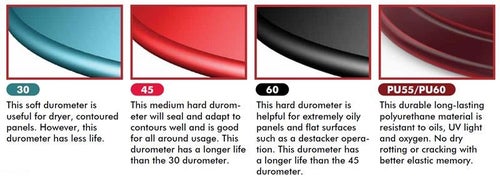When Selecting A Vacuum Cup - What Is Durometer?
The concept of “durometer” is also known as “Shore durometer” in honor of Albert Ferdinand Shore, who developed a device in the 1920s that was able to measure the hardness of rubbers, polymers and elastomers. The durometer scale, which ranges from 0 to 100, is technically a “dimensionless” measurement since there is no actual durometer unit of measurement. An object’s durometer is determined by measuring the depth of an indentation that is made in it via a standardized indenter or presser tool. A higher durometer number indicates greater resistance to indentation, making the material harder, while a lower number indicates lower resistance and a softer material.
In the world of vacuum cups, most of which are constructed of rubber or polyurethane, durometer will let the user know how flexible the cup is, which will help determine the type of objects it can be used with in pick-and-place or workholding applications. When choosing a durometer for the application, remember that contoured parts, or those with sharp corners or edges, need a softer durometer so that the vacuum cups can more easily grip the contours. Flat surfaces are ideal for harder durometers because the vacuum cup will have stronger holding properties. Both the rubber and polyurethane-based cups that are on the market today use the Shore A scale to denote their durometer.

Here are some examples of durometer measurements and the type of objects they are able to handle successfully:
- 30 - This is a relatively soft durometer that makes the vacuum cup ideal for use with contoured panels. It may, however, have a shorter life cycle than harder durometer vacuum cups.
- 45 - This durometer reading indicates a medium-hard rubber that will effectively seal and adapt to most contours, which makes it good for all-around usage. Because it is harder than a 30-durometer vacuum cup, it can be expected to have a longer operational life.
- 60 - This is typically the hardest durometer that a vacuum cup can be; anything harder will not give the cup enough flexibility to perform its duties. Vacuum cups this hard are effective with extremely oily flat surfaces. Because of its hardness, a 60-durometer vacuum cup will last longer than softer 30- or 45-durometer models.
While the durometer should make it easy for users to identify the best cup for their applications, some vacuum-cup manufacturers will also color-code their products by durometer for easy identification, maintenance and replacement.
Contact our experts to share your application goals and technical specification today!

